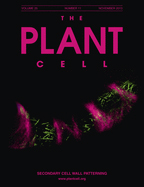- EN - English
- CN - 中文
Subchromoplast Fractionation Protocol for Different Solanaceae Fruit Species
不同茄科果实物种有色体亚群的分级分离方法
发布: 2016年07月05日第6卷第13期 DOI: 10.21769/BioProtoc.1861 浏览次数: 9346
Abstract
Macromolecules, proteins, lipids, and other small molecules, such as carotenoids can be studied within different tissues and organelles using an array of in vitro and in vivo methodologies. In the case of tomato and other fleshy fruit the predominant organelle in ripe fruit is the chromoplast. The characteristic feature of this organelle is the presence of pigments, carotenoids at high levels. In order to fully understand the underlying biological mechanisms that operate within the chromoplast, it is necessary to perform studies at the subchromoplast level. This protocol allows the separation of plastoglobules (lipoprotein particles, which are coupled to thylakoid membranes in the chloroplasts) and membranes (thylakoid, envelope-like) of chromoplasts through a sucrose gradient. The subchromoplast compartments can then be analysed independently. Comparisons between mutant/transgenic genotypes and their backgrounds can be performed accurately with simultaneous processing during the same fractionation run. The procedure was initially developed for ripening tomato fruit but translation to sweet and hot pepper has been shown.
Materials and Reagents
- 50 ml Falcon tubes (Sigma-Aldrich, catalog number: Greiner227261 )
- Muslin (MacCulloch & Wallis, catalog number: 4470 )
- Plants
- Tomato (90 to 150 g of breaker +3 to 5 days fruit per condition)
- Sweet bell pepper (30 to 120 g of ripe fruit per condition; depending on fruit pigment content)
- Hot chilli pepper (~30 g of ripe fruit per condition)
- Tomato (90 to 150 g of breaker +3 to 5 days fruit per condition)
- DL-dithiothreitol (DTT) (Sigma-Aldrich, catalog number: 43815 )
- Sucrose (Sigma-Aldrich, catalog number: S0389 )
- Trizma base (Tris) (Sigma-Aldrich, catalog number: T1503 )
- EDTA (Sigma-Aldrich, catalog number: E5134 )
- Tricine (Sigma-Aldrich, catalog number: T0377 )
- Sodium bisulphite (sodium metabisulfite) (Sigma-Aldrich, catalog number: S9000 )
- Extraction buffer (see Recipes)
- Gradient buffers (see Recipes)
Equipment
- Cold room (4 °C)
- -20 °C room
- Centrifuge Sorvall RC-5C (Thermo Scientific)
- Fixed angle rotor Sorvall GSA-3 (purple colour) (Thermo Scientific)
- Fixed angle rotor Sorvall GSA-5 (green colour) (Thermo Scientific)
- Ultracentrifuge Beckman L7 (Beckman Coulter)
- Swing rotor SW28 (Beckman Coulter)
- 500 ml centrifuge bottles (Thermo Fisher Scientific, NalgeneTM, model: 3141-0500 )
- 50 ml centrifuge tubes (Thick-wall UltraTubes) (Thermo Fisher Scientific, NalgeneTM, model: 3110-0500 )
- 38.5 ml centrifuge tubes (Beckman Coulter, Ultra-ClearTM, model: 344058 )
- Glass flask conical narrow neck 5 L (Fischer Scientific, FisherbrandTM, model: 11597422 )
Note: This product has been withdrawn by the manufacturer. [Replacement item: Borosilicate glass narrow neck Erlenmeyer flasks (Fischer Scientific, FisherbrandTM, model: 15479103 )] - Waring blender (small laboratory blender 8010ES) (Scientific Labs, model: MIX1126 )
- Potter-Elvehjem tissue grinder (VWR International, model: 14231-372 )
- Fraction collector (Gilson, model: 203B )
- Suitable ice containers
- Funnel (glass or plastic, to fit 5 L conical flasks)
Procedure
文章信息
版权信息
© 2016 The Authors; exclusive licensee Bio-protocol LLC.
如何引用
Nogueira, M., Berry, H., Nohl, R., Klompmaker, M., Holden, A. and Fraser, P. D. (2016). Subchromoplast Fractionation Protocol for Different Solanaceae Fruit Species. Bio-protocol 6(13): e1861. DOI: 10.21769/BioProtoc.1861.
分类
细胞生物学 > 细胞器分离 > 有色体
您对这篇实验方法有问题吗?
在此处发布您的问题,我们将邀请本文作者来回答。同时,我们会将您的问题发布到Bio-protocol Exchange,以便寻求社区成员的帮助。
提问指南
+ 问题描述
写下详细的问题描述,包括所有有助于他人回答您问题的信息(例如实验过程、条件和相关图像等)。
Share
Bluesky
X
Copy link















